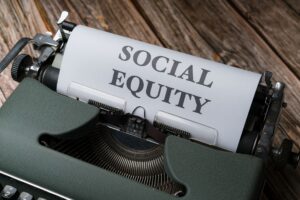
The Infrastructures Bill’s Potential Impact on the EWD Sector
Pam Sornson, JD
January 2, 2024
Deep in the heart of the Covid pandemic, America’s national leaders did an extraordinary thing. On November 6, 2021, they passed the Infrastructure Investment and Jobs Act (IIJA), “a once-in-a-generation investment in our nation’s infrastructure and competitiveness.” The Bipartisan Act commits over one trillion dollars to repairing America’s decaying infrastructure while building new foundational resources to meet 21st-century demands. The new law will address two critical national concerns at once:
the repairing of the country’s substructure systems (railways, bridges, highways, etc.)
while also generating the jobs and business opportunities that will ensure a stable economy.
Embedded in its provisions are mandates requiring equitable practices across all industries so that the nation’s residents have the employment, income, and work opportunities they need to accomplish their personal goals. The IIJA is an attempt to address many or most of the complex issues America faces today while also adding resources to expand the country’s vast potential.

Repairing Aging Systems
Studies conducted over the past several years clearly reveal that the nation’s infrastructure systems are decaying. Much of that foundation was built decades ago, and it is suffering extreme distress because of the population explosion that occurred in the intervening years.
According to government reports, 20% of America’s highways and 45,000 bridges are failing. The roads require repaving at the least, and many require additional substructure repair to retain their usability into the future. Bridge inspections show cracks, separations, lost connectors, and other signs of deterioration. In almost all cases, obsolete materials and extreme overuse are causing the problems.
The airports are also showing serious signs of wear and tear, as are the country’s ports of entry. These assets play a crucial role in the nation’s economy, underpinning its extensive network of supply chains.
Public transport options are also suffering from years of neglect and deferred maintenance. America needs at least 24,000 new buses, 5,000 metro cars, and thousands of miles of train tracks to serve today’s population.
Public water systems are also in disarray; many still use life- and health-threatening lead pipes, and studies show that as many as 10 million homes are without safe drinking water.
The country relies on each of these systems to maintain its economic activity and provide healthy, happy communities for its residents. Further, in many cases, providing these resources will alleviate much of the inequities caused when transportation options are few and far away, as is the case in many of America’s ethnic communities. The IIJA investments promise a safer, more adaptable infrastructure foundation that upgrades its capacities while adding resources to address emerging demands, opportunities, and realities.

Building in New Resources
The IIJA also looks ahead. The IIJA aims to spend much of its investment dollars on building – at a national level – the resources needed for every local community to thrive and compete economically.
Digital resources are driven by the internet, and without that asset readily available, communities suffer. This was just one significant fact revealed during the pandemic. Thousands of remote communities lost contact with their neighbors and support services when communications channels were only available through an internet connection.
The realities of climate change are also compelling a rethinking of how systems should work. The IIJA invests heavily in electric vehicles and the network of public charging stations that will keep them running. This specific project serves two purposes: it will reduce the country’s negative impact on the climate while also increasing manufacturing employment opportunities. The rebuilding process will include accommodations for current and future threats caused by floods, storms, drought, etc., and the enhanced, ‘greener’ public transportation system will eliminate millions of tons of greenhouse gas emissions.
And clean, reliable energy itself is a central element of the two-year-old law. The Department of Energy reports that power outages across the country cost its citizens as much as $70 billion each year. In areas where extreme heat is happening more frequently, the number of lives lost to climate change is also growing. The nation’s electric grid is in serious need of an overhaul and modernization effort; the IIJA intends to ensure it gets that attention.
With funds directed at repairing failing systems while building in new resources, the IIJA promises to bring America’s foundation back to its former glory, a model for the world on how a booming and free economy thrives.

Creating Economic Stability
For many years, the American economy has been tilting toward the wealthy in terms of growth opportunities and reductions in tax contributions. The IIJA will remedy some of these inequities by improving publicly available resources in previously underserved places, typically in communities of lower economic status. The infrastructure investments themselves will have an impact – those efforts routinely represent positive contributions to local, regional, and national GDP and employment numbers. But where the strategy might be most helpful is its intention to hire and employ the millions of workers needed to bring its goals to fruition.
And to hire that labor force, those workers must first be trained and ready to work. According to the Brookings Institute, a nationwide, all-encompassing training effort will require inputs from every element of the economic sector. Businesses, industries, governments, and educators must all work together to develop occupationally focused education systems needed to sustain the IIJA’s upward trajectory. Those experts also suggest ways to accomplish these lofty goals. They suggest that the country should:
Increase investments in training programs, including upskilling and reskilling options. At best, today’s existing workforce training resources are only moderately adequate because most do not yet incorporate the digital aspect of the emerging workforce environment.
Utilize more work-based learning options, including apprenticeships, internships, and union participation. Very few school-based programs can match the efficacy and efficiency that come from on-the-job training.
Embrace diversity as an economic asset. Too many people are left out of the workforce for no other reason than their ethnicity, heritage, or even sexual orientation. The Brookings leaders assert that those human resources can provide immense value to their communities both as workers and as leaders. Adding their capacities will result in improved economic outcomes across all segments of the population.
Passage of the IIJA was a noteworthy accomplishment because it aims to both rebuild America’s aging infrastructure and also construct a future economy that supports a successful future for everyone. This ‘once in a generation’ investment will surely benefit not just this generation but all of those yet to come.


